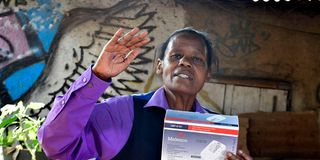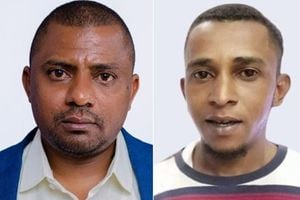Champion making HIV patients take their ARVs diligently

Rita Beatrice, a community health promoter who has lived with HIV for 22 years, holds a blood pressure monitor which she uses when taking care of patients in their homes in Silanga, Kibra on February 1, 2024.
What you need to know:
- Twenty years ago, ARVs were harder and more expensive to come by. Thousands of patients would sit and wait for their inevitable death. Not so today.
- HIV is no longer a death sentence. The toolkit to fight the virus is advancing. ARVs are more potent now. Many people have access to them.
It is 6am on a Friday and Rita Beatrice, 50, is busy preparing breakfast. For this woman, life depends on the first meal of the day. “The meal allows me to take my medicine,” says the mother of eight who has lived with HIV/Aids for 22 years.
Rita works as a community health promoter in Kibra, Nairobi and for two decades, she has dedicated her life to an uncommon cause: hunting down antiretroviral drugs (ARVs)defaulters. She knows the ridges of this sprawling settlement all too well, having lived here for more than 30 years.
Hers is a tough, time-consuming and frustrating cause. One that she does without pay, except a Sh3,500 monthly stipend that the government advances to community health promoters (CHPs) like her. This is all she lives by.

Rita Beatrice measures the blood pressure of Erick Mutie at his home in Silanga, Kibra on February 1, 2024.
Rita tells Healthy Nation that she discovered her HIV status by happenstance. “I found out that I had HIV when I gave birth outside my house in the middle of a heavy downpour. Upon being rushed to hospital, the doctor broke the news after conducting a series of blood tests . Since then I have been on ARVs,” she tells Healthy Nation.
While admitting that the landscape of HIV has drastically changed in recent years, she reveals that stigma rages on, particularly in social settings. Discrimination for patients is still rife.
‘‘Some employers demand a HIV test before giving people work. This destroys people psychologically. Some abandon their drugs for fear of being stigmatised.’’
Others shun health facilities where these drugs are collected. It is even harder for those who live in underprivileged neighbourhoods like Kibra. “For many years, we did not know about the laws that protect people from discrimination. This has changed, but we have a long road to travel.’’
A long road that involves training patients on their rights by different individuals and entities. Rita is one of the beneficiaries of this training by Médecins Sans Frontières (MSF), popularly known as Doctors Without Borders.
Now she offers this training to others in her neighbourhood. “After breakfast, my day begins with a door-to-door visit to hunt down those who have defaulted on ART.’’
Her first stop is at Amref Health Centre in Kibra, where she is provided with a list of recent and past defaulters. Braving the hot sun or cold, she sets off to meet patients, most of them strangers, in an attempt to reintroduce them to the pills.
For those she cannot reach physically, she calls them and traces their houses. “It is not easy as some people will develop all manner of excuses not to talk or meet. But I have to keep trying,” she says.
Dealing with some of the patients is further complicated by other underlying challenges such as acute poverty. For patients with no reliable livelihood, food is the primary need. To them, ARVs are a secondary need, Rita notes. The economic situation has made it even harder, leading to more defaults.
‘‘Many patients prefer to get their medication in faraway health facilities where no one knows them. The time needed for treatment, the cost of transport as well as balancing work schedules weighs heavily down on them.’’
“Even after getting these people back on track, some fall off track again. You have to look for them again,’’ she says, adding that this process sometimes takes months. For discordant couples, staying on treatment by one of the partners is safe enough, although treatment by both is encouraged.
Whenever she gets hold of an ARV defaulter, Rita first takes them back to a health facility for doctors to establish their viral load through a test. This is the amount of HIV in the blood. The test measures the number of HIV copies in one millilitre of blood.
A viral load is considered high when its above 100,000 copies per millilitre of blood, but you could have one million or more. Rita’s current patient was found to have a viral load of over 500,000 copies, putting her life in acute danger of infection from other common illnesses. Viruses work by making copies of themselves, making the disease to progress quickly.
A test allows the healthcare provider to determine the level and behaviour of a patient’s infection so as to inform treatment choices. Rita explains that the viral load is highest during the acute phase of HIV (the earliest stage of HIV infection which generally develops within two to four weeks after infection), especially in the absence of treatment.
“Some people develop flu-like symptoms such as fever, headache and rashes. In the acute stage of infection, HIV multiplies rapidly and spreads throughout the body,” she notes. Taking HIV medicine, however, reduces the viral load, making it so low that tests sometimes fail to detect the virus. We call this an undetectable viral load. This suppression of the virus allows the patient to live a long, healthy live.”
This also helps to prevent transmission of the virus to others through sex or sharing needles, syringes or other injection equipment. ‘‘At this stage, a mother cannot transmit the virus to her child during pregnancy, birth or breastfeeding.”
Doing this type of work is expensive, she says. For Rita and other CHPs, the Sh3,500 stipend is only paid upon getting 100 defaulters back on the drug. ‘This is the money I spend on airtime and data to stay in touch with the patients. Sometimes the stipend is delayed, disrupting my work.’’
It is also about making sacrifices. Sometimes she runs into debt. ‘‘The pay is not sustainable. I have children and grandchildren to fend for. But I have to do this to give others hope because other people encouraged me when I tested positive.’’
Twenty years ago, ARVs were harder and more expensive to come by. Thousands of patients would sit and wait for their inevitable death. Not so today, she says. ‘‘HIV is no longer a death sentence. The toolkit to fight the virus is advancing. ARVs are more potent now. Many people have access to them.’’
Researchers says that increasing access to antiretroviral therapy (ART) drugs, especially in low-income countries, has decreased HIV fatalities while increasing survival.
The rate of default, she reveals, is higher among the youth, many of them below 30 years. ‘‘They say they are overwhelmed by the routine. Others are bogged down by their side effects.’’ These range from appetite loss to diarrhoea, fatigue and mood swings.
Failure to stick to a treatment plan, she says, often makes the virus resistant to drugs and harder to treat. “To live, you must take the drugs for the rest of your life without fail. ‘‘I am alive and healthy today because I have religiously taken my medication for 22 years. My viral load is now almost negligible.’’
But even with less than 20 copies of viral load, it does not mean she is cured. ‘‘I must keep taking the drugs.’’
Thanks to her work, Rita was among 100,000 CHPs across Kenya who President William Ruto gave kits to support their work in September last year. The kit comes with a first aid box, a reflector jacket, a backpack, an infrared clinical thermometer and a weighing scale.
‘‘The tool has made my work more efficient. I can now attend to patients from as early as 7am to as late as 9pm.’’ Besides the fulfilment of changing lives, this has also been a journey of discovery for Rita. For many adult patients, she says, cardiovascular diseases are a common risk factor.
Part of her work involves monitoring TB patients as well to ensure compliance with drug uptake. ‘‘These patients must also be eating well because good nutrition supports their overall health and strengthens their immune system. A weak body cannot absorb medicine properly.’’
HIV damages the immune system, she says, making food-borne illnesses more serious and longer lasting than in healthy people. “Good nutrition entails eating fruits, vegetables, grains, proteins and dairy. These foods have to be eaten in the right quantities.’’
For expectant mothers, Rita has lessons from her 22-year battle with the virus. “The mother-to-child transmission is real. I am a living example.’’
To this end, she encourages mothers to start their clinic visits early for doctors to advise them on the journey. ‘‘By opting to feed your infant with formula or pasteurised donor milk, one can prevent transmitting the virus to their baby.’’
‘‘By taking HIV medicine and maintaining an undetectable viral load during pregnancy, labour and delivery reduces transmission through breastfeeding to less than one per cent,” she says.
“My next patient is Patient Number 7,560 in the last three years,” she informs the Healthy Nation team as we move to the next household. ‘‘This one has defaulted for eight weeks, plunging her into depression.’’
For Rita, every day lived with HIV is a battle won. On some days, though, the battle is so tough she wants to give up. But Rita knows she cannot afford to capitulate. Her resilience is the central plank on which other patients fight their own battle. A battle to stay on ARVs to prolong their life.





